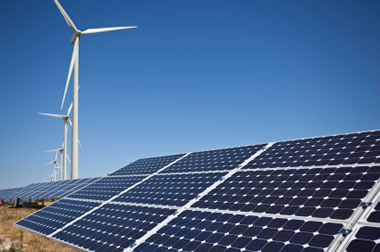Isabel Atkinson,
Staff Writer
Photo from geology.com
California continues to lead the country in developing approaches for producing and using renewable energy sources after Governor Jerry Brown and Secretary of the Interior Ken Salazar signed an agreement Jan.13 that will expand the undergoing projects even further. These projects not only propel California towards reaching its renewable energy goals but will create thousands of jobs within the state.
The partnership established between the federal and California state government in 2009 was implemented to determine feasible and environmentally sound methods of generating clean energy. The agreement entitled the Memorandum of Understanding brings other organizations on board including the California Independent System Operator, the California Public Utilities Commission and the California State Lands Commission, who are each responsible for managing various aspects of California’s energy and land resources.
Over the past few years, progress has been made in regards to the creation of renewable energy. The agreement instigates the construction of transmission lines for the transport of energy across the state that will simultaneously create work for thousands of California residents. Also in collaboration is the Renewable Energy Policy Group, whose job is to evaluate each project based on standards of environmental impact. The state and federal governments strongly advise developers of clean energy projects to find land with a minimal negative environmental effect. Once a plot is chosen, the area must undergo an environmental review before moving forward with the project.
“In addition to fauna and flora, they’re looking at the impact on native plants as well as hydrology,” said Bill Powers of Powers Engineering. Powers used desert lands as an example–the organisms there that rely on floodwater for sustenance would be disrupted if a solar power plant was built and the water rerouted to preserve its construction.
With biome disturbance at a minimum, the construction of the seven major renewable power plants together will likely result in one third of California ‘s energy deriving from renewable sources–the state’s current goal.
Professor Mel Manalis, the senior lecturer of the environmental studies program at University of California Santa Barbara supports the development of renewable energy sources but believes that the behavioral use of energy should be considered equally.
“If you’re going to put solar cells on your house and displace coal electricity, it behooves you to make sure your light bulbs are replaced with LEDs,” Manalis said. “What you’re doing is getting a double gain.”
Although wind energy exceeds solar in efficiency, the focus weighs heavily on solar energy because of its accessibility. In addition to the big projects, the agreement strives to make renewable energy available to private homes and commercial buildings as well. Wind turbines cannot function everywhere, but solar cells can.
“We prefer what’s called distributed solar,” said Professor of environmental law and policy Linda Krop. She emphasizes the importance of making clean energy reachable to individuals through the construction of solar panels on existing buildings and rooftops. Professor Krop also states that she supports legislation that would allow home owners With private solar installations to sell unused energy back to the utility company.
Individual initiative in conjunction with seven major renewable energy developments makes it possible for California to reach and potentially exceed its goals for a decreased reliance on fossil fuels. Major challenges stand in the way, but clean energy projects are one of Brown’s top priorities. Despite the endless stream of cars that frequent California’s highways, the state still strives for a greener future.












Comments are closed.